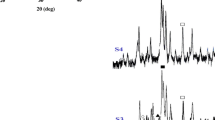Abstract
Nano-sized hydroxyapatite (HA) particles were synthesized by sol-gel through water and ethanol based mediums of phosphoric acid (H3PO4) and calcium hydroxide (Ca(OH)2) at pH = 11 for different calcination time (1 h, 2 h, 4 h). The effects of calcination time and solution on the crystallinity, morphology and impurity phases of the HA nanoparticles were examined via Fourier Transform Infrared (FTIR), Scanning Electron Microscopy (SEM), Energy Dispersive X-ray Spectroscopy (EDS) and X-ray Diffraction (XRD). It was found that crystallite size and the fraction crystallinity of the synthesized samples increased with calcination time. According to solution medium, only CaO as impurity was appeared in the water-based solvent, CaO and Ca(OH)2 impurities were appeared in the ethanol-based solvent. The lowest crystallinity was 0.92 and the highest crystallinity was 1.73 respectively, depending on the process parameters. The Ca/P atomic ratio closest to the bone was found as 1.5178. As a result, the employed water-based sol-gel processes for 1 h calcination time was determined as the optimum for the formation of nano-sized HA powders using calcium hydroxide and phosphoric acid.
Similar content being viewed by others
References
Gopi D, Kavitha L, Rajeswari D. Synthesis of pure and substituted hydroxyapatite nanoparticles by cost effective facile methods, In Aliofkhazraei M ed., Handbook of Nanoparticles, 2015, 167–190.
Cai Y R, Liu Y K, Yan W Q, Hu Q H, Tao J H, Zhang M, Shi Z L, Tang R K. Role of hydroxyapatite nanoparticle size in bone cell proliferation. Journal of Materials Chemistry, 2007, 17, 3780–3787.
Dorozhkin S V. Nanosized and nanocrystalline calcium orthophosphates. Acta Biomaterialia, 2010, 6, 715–734.
Dong Z H, Li Y B, Zou Q. Degradation and biocompatibility of porous nano-hydroxyapatite/polyurethane composite scaffold for bone tissue engineering. Applied Surface Science, 2009, 255, 6087–6091.
Wang Y Y, Liu L, Guo S R. Characterization of biodegradable and cytocompatible nano-hydroxyapatite/polycaprolactone porous scaffolds in degradation in vitro. Polymer Degradation and Stability, 2010, 95, 207–213.
Sadat-Shojai M, Khorasani M T, Dinpanah-Khoshdargi E, Jamshidi A. Synthesis methods for nanosized hydroxyapatite with diverse structures, Acta Biomaterialia, 2013, 9, 7591–7621.
Vallet-Regí M, González-Calbet J M. Calcium phosphates as substitution of bone tissues. Progress in Solid State Chemistry, 2004, 32, 1–31.
Liu D M, Troczynski T, Tseng W J. Water-based sol-gel synthesis of hydroxyapatite: Process development. Scanning Electron Microscopy, 2001, 22, 1721–1730.
Liou S C, Chen S Y, Lee H Y, Bow J S. Structural characterization of nano-sized calcium deficient apatite powders. Biomaterials, 2004, 25, 189–196.
Türk S, Altınsoy İ, ÇelebiEfe G, Ipek M, Özacar M, Bindal C. Microwave-assisted biomimetic synthesis of hydroxyapatite using different sources of calcium. Materials Science and Engineering: C, 2017, 76, 528–535.
Bose S, Saha S. Synthesis of hydroxyapatite nanopowders via sucrose-templated sol-gel method. Journal of the American Ceramic Society, 2003, 86, 1055–1057.
Eshtiagh-Hosseini H, Housaindokht M R, Chahkandi M. Effects of parameters of sol-gel process on the phase evolution of sol-gel-derived hydroxyapatite. Materials Chemistry and Physics, 2007, 106, 310–316.
Hsieh M F, Perng L H, Chin T S, Perng H G. Phase purity of sol-gel-derived hydroxyapatite ceramic. Biomaterials, 2001, 22, 2601–2607.
Fathi M H, Hanifi A, Mortazavi V. Preparation and bioactivity evaluation of bone-like hydroxyapatite nanopowder. Journal of Materials Processing Technology, 2008, 202, 536–542.
Michael F M, Khalid M, Ratnam C T, Chee C Y, Rashmi W, Hoque M E. Sono-synthesis of nanohydroxyapatite: Effects of process parameters. Ceramics International, 2015, 42, 6263–6272.
Waheed S, Sultan M, Jamil T, Hussain T. Comparative analysis of hydroxyapatite synthesized by sol-gel, ultrasonication and microwave assisted technique. Materials Today: Proceedings, 2015, 2, 5477–5484.
Bakan F, Laçin O, Sarac H. A novel low temperature sol-gel synthesis process for thermally stable nano crystalline hydroxyapatite. Powder Technology, 2013, 233, 295–302.
Huang Z, Zhou Q, Wang X F, Liu Z C. A biomimetic synthesis process for Sr2+, HPO4 2-, and CO3 2- substituted nanohydroxyapatite. Materials and Manufacturing Processes, 2016, 31, 217–222.
Degirmenbasi N, Kalyon D M, Birinci E. Biocomposites of nanohydroxyapatite with collagen and poly(vinyl alcohol). Colloids Surfaces B: Biointerfaces, 2006, 48, 42–49.
Fan W, Sun Z, Wang J, Zhou J, Wu K, Cheng Y. Evaluation of Sm0.95Ba0.05Fe0.95Ru0.05O3 as a potential cathode material for solid oxide fuel cells. RSC Advances, 2016, 6, 34564–34573.
Sanosh K P, Chu M C, Balakrishnan A, Lee Y J, Kim T N, Cho S J. Synthesis of nano hydroxyapatite powder that simulate teeth particle morphology and composition. Current Applied Physics, 2009, 9, 1459–1462.
Currey J. Sacrificial bonds heal bone. Nature, 2001, 414, 699.
Pang Y X, Bao X. Influence of temperature, ripening time and calcination on the morphology and crystallinity of hydroxyapatite nanoparticles. Journal of the European Ceramic Society, 2003, 23, 1697–1704.
Chen L, Tang C Y, Ku H S, Tsui C P, Chen X. Microwave sintering and characterization of polypropylene/multi-walled carbon nanotube/hydroxyapatite composites. Composites Part B: Engineering, 2014, 56, 504–511.
Paz A, Guadarrama D, López M, González J E, Brizuela N, Aragón J. A comparative study of hydroxyapatite nanoparticles synthesized by different routes. Química Nova, 2012, 35, 1724–1727.
Varma H K, Babu S S. Synthesis of calcium phosphate bioceramics by citrate gel pyrolysis method. Ceramics International, 2005, 31, 109–114.
Mujahid M, Sarfraz S, Amin S, Road J. On the formation of hydroxyapatite nano crystals prepared using cationic surfactant. Materials Research-Ibero-American Journal of Materials, 2015, 18, 468–472.
Author information
Authors and Affiliations
Corresponding author
Rights and permissions
About this article
Cite this article
Türk, S., Altınsoy, İ., Çelebi Efe, G. et al. Effect of Solution and Calcination Time on Sol-gel Synthesis of Hydroxyapatite. J Bionic Eng 16, 311–318 (2019). https://doi.org/10.1007/s42235-019-0026-3
Published:
Issue Date:
DOI: https://doi.org/10.1007/s42235-019-0026-3




